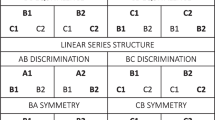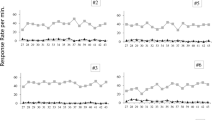Abstract
A systematic replication of Hearst’s (1989) demonstration of excitatory, appetitive backward conditioning with pigeons was undertaken. On each training session, two types of backward conditioning trials were presented: On positive trials, hopper presentation (the unconditioned stimulus, or US) was followed by illumination of a pigeon key (the positive backward conditioned stimulus, or CS) for 6 s. On negative trials, a different 6-s keylight (the negative backward CS) followed presentation of the hopper light alone. Associative strength was assessed on higher-order, summation, resistance-to-reinforcement, and extinction test sessions, using two measures—key pecking and key approach (proximity duration). Consistent with Hearst’s findings, pigeons rarely pecked during backward conditioning training; however, during resistance-to-reinforcement tests, birds acquired keypeck responding more rapidly to the positive versus the negative backward cue. In Experiment 2, maintained proximity duration was higher to the positive versus the negative CS on resistance-to-reinforcement tests in both between- and within-subject comparisons. These results, which extend those of Hearst to a within-subject assay of backward conditioning, and to an alternate measure of performance, suggest that appetitive backward conditioning is a reliable phenomenon, the parameters of which require further exploration.
Similar content being viewed by others
References
AYRES, J. J. B., HADDAD, C., & ALBERT, M. (1987). One-trial excitatory backward conditioning as assessed by conditioned suppression of licking in rats: Concurrent observations of lick suppression and defensive behaviors. Animal Learning & Behavior, 15, 212–217.
BOAKES, R. A. (1977). Performance on learning to associate a stimulus with positive reinforcement. In H. Davis & H. M. B. Hurwitz (Eds.), Operant-Pavlovian interactions (pp. 67–97). Hillsdale, NJ: Lawrence Erlbaum.
BROWN, B. L., HEMMES, N. S., CABEZA DE VACA, S., & PAGANO, C. (1993). Sign and goal tracking during delay and trace autoshaping in pigeons. Animal Learning & Behavior, 21, 360–368.
BROWN, B. L., HEMMES, N. S., COLEMAN, D. A., JR., HASSIN, A., & GOLDHAMMER, E. (1982). Specification of the stimulus-reinforcer relation in multiple schedules: Delay and probability of reinforcement. Animal Learning & Behavior, 10, 365–376.
BUZSAKI, G. (1982). The “Where is it?” reflex: Autoshaping the orienting response. Journal of the Experimental Analysis of Behavior, 37, 461–484.
FANTINO, E. (1977). Conditioned reinforcement: Choice and information. In W. K. Honig & J. E. R. Staddon (Eds.), Handbook of operant behavior (pp. 313–339). Englewood Cliffs, NJ: Prentice-Hall.
GIBBON, J., BERRYMAN, R., & THOMPSON, R. L. (1974). Contingency spaces and measures in classical conditioning. Journal of the Experimental Analysis of Behavior, 21, 585–605.
HEARST, E. (1987). Extinction reveals stimulus control: Latent learning of feature-negative discriminations in pigeons. Journal of Experimental Psychology: Animal Behavior Processes, 13, 52–64.
HEARST, E. (1989). Backward associations: Differential learning about stimuli that follow the presence versus the absence of food in pigeons. Animal Learning & Behavior, 17, 280–290.
HEMMES, N. S., BROWN, B. L., & CABEZA DE VACA, S. (1990). Effects of trial duration on overall and momentary rates of maintained autoshaped keypecking: Choice and single stimulus trials. Animal Learning & Behavior, 18, 171–178.
HOLLAND, P. C. (1977). Conditioned stimulus as a determinant of the form of the Pavlovian conditioned response. Journal of Experimental Psychology: Animal Behavior Processes, 3, 77–104.
JENKINS, H. M., BARNES, R. A., & BARRERA, F. J. (1981). Why autoshaping depends upon trial spacing. In C. M. Locurto, H. S. Terrace, & J. Gibbon (Eds.), Autoshaping and conditioning theory (pp. 255–284). New York: Academic Press.
KAPLAN, P. S. (1984). Importance of relative temporal parameters in trace autoshaping: From excitation to inhibition. Journal of Experimental Psychology: Animal Behavior Processes, 10, 113–126.
KONORSKI, J. (1967). Integrative activity of the brain. Chicago: University of Chicago Press.
LINDBLOM, L. L., & JENKINS, H. M. (1981). Responses eliminated by noncontingent or negatively contingent reinforcement recover in extinction. Journal of Experimental Psychology: Animal Behavior Processes, 7, 175–190.
LOLORDO, V. M., & FAIRLESS, J. L. (1985). Pavlovian conditioned inhibition: The literature since 1969. In R. R. Miller & N. E. Spear (Eds.), Information processing in animals: Conditioned inhibition (pp. 1–49). Hillsdale, NJ: Lawrence Erlbaum.
MATZEL, L. D., HELD, F. P., & MILLER, R. R. (1988). Information and expression of simultaneous and backward associations: Implications for contiguity theory. Learning and Motivation, 19, 317–344.
OVERMIER, J. B., BULL, J. A., III, & TRAPOLD, M. A. (1971). Discriminative cue properties of different fears and their role in response selection in dogs. Journal of Comparative and Physiological Psychology, 76, 478–482.
RESCORLA, R. A. (1978). Some implications of a cognitive perspective on Pavlovian conditioning. In S. H. Hulse, H. Fowler, & W. K. Honig (Eds.), Cognitive processes in animal behavior (pp. 15–50). Hillsdale, NJ: Lawrence Erlbaum.
RESCORLA, R. A. (1989). Redundant treatments of neutral and excitatory stimuli in autoshaping. Journal of Experimental Psychology: Animal Behavior Processes, 15, 212–223.
SPETCH, M. L., WILKIE, D. M., & PINEL, J. P. J. (1981). Backward conditioning: A reevaluation of the empirical evidence. Psychological Bulletin, 89, 163–175.
TAIT, R. W., & SALADIN, M. E. (1986). Concurrent development of excitatory and inhibitory associations during backward conditioning. Animal Learning & Behavior, 14, 133–137.
WASSERMAN, E. A., FRANKLIN, S. R., & HEARST, E. (1974). Pavlovian appetitive contingencies and approach versus withdrawal to conditioned stimuli in pigeons. Journal of Comparative and Physiological Psychology, 86, 616–627.
ZENER, K. (1937). The significance of behavior accompanying conditioned salivary secretion for theories of the conditioned response. American Journal of Psychology 50, 384–403.
ZENTALL, T. R., SHERBURNE, L. M., & STEIRN, J. N. (1992). Development of excitatory backward associations during the establishment of forward associations in a delayed conditional discrimination by pigeons. Animal Learning & Behavior, 20, 199–206.
Author information
Authors and Affiliations
Additional information
This research was supported in part by PSC/CUNY Grant 662434 to Nancy Hemmes and Bruce Brown. A portion of the data was reported at the meeting of the Eastern Psychological Association in April, 1992. We gratefully acknowledge the contributions of the following students to various aspects of the research: James Jakubow, Eleni Palmos, Rondalf Taylor, and Susan Vener.
Rights and permissions
About this article
Cite this article
Hemmes, N.S., Brown, B.L. & Cabeza De Vaca, S. Appetitive Backward Conditioning in Pigeons. Psychol Rec 44, 221–237 (1994). https://doi.org/10.1007/BF03395129
Published:
Issue Date:
DOI: https://doi.org/10.1007/BF03395129




